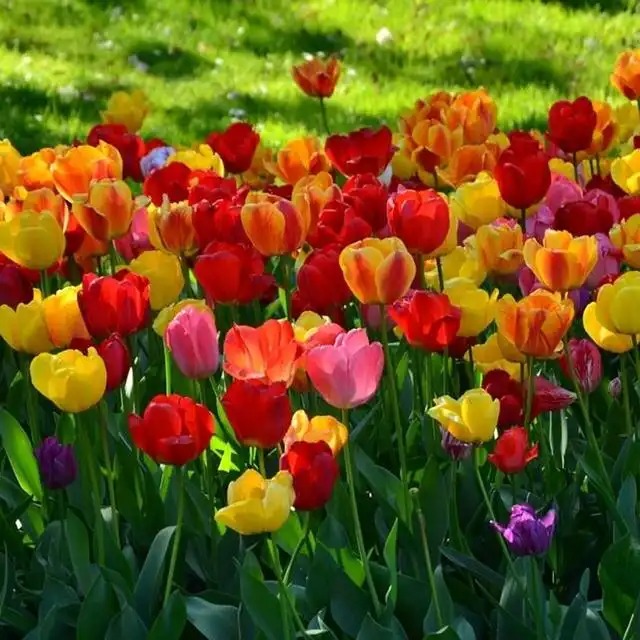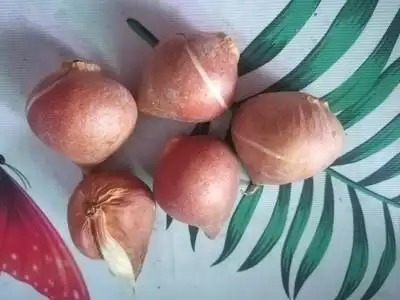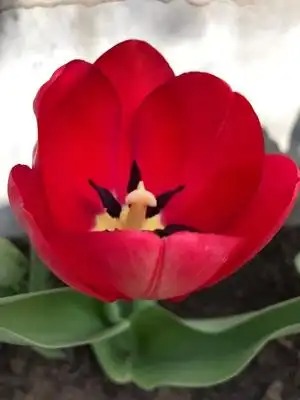Tulip and its key cultivation techniques
Tulip and its key cultivation techniques
Wang Zhongliang
Tulips, also known as "foreign lotus", "grass musk" and "foreign daffodil", belong to the lily family and are one of the ornamental plants widely planted in Lanzhou in recent years to beautify the city and attract tourists. Tulips are high-standard ceremonial flowers, mostly used to decorate large-scale celebrations and high-end places. "The vast tulips are on the arms, and the graceful ancient jade pendants are on the waist." Tulips were used to make spices in ancient times; Gao Qi of the Ming Dynasty wrote in his poem "Gusu Terrace": "The incense burner is always burning tulips, and we share the joy of a thousand years." In ancient times, tulips were used as raw materials to make incense for burning. Therefore, tulips have been appreciated and used to beautify life from ancient times to the present.

1 Morphological characteristics
Tulip is a perennial herb with an oblate conical bulb, a yellowish or brownish brown outer membrane, a circumference of about 8 to 12 cm, and 3 to 5 fleshy scales inside. There are 2 to 4 leaves, which grow in the middle and lower part of the stem. They are broadly lanceolate to ovate needle-shaped, with 2 at the base, long and broad at the top, entire and wavy, thick and juicy, and a gray wax layer on the leaf surface. The diameter of the tulip is upright and smooth, with white powder on the surface. The flower of the tulip grows solitarily at the top of the stem, with 6 petals arranged in 2 rounds. Some double varieties have about 25 to 35 petals. The flowers are large and come in various shapes, including bowl-shaped, cup-shaped, saucer-shaped, lily-shaped, star-shaped, etc. Most of the tepals have smooth edges, while a few have wavy teeth, serrations, notches, and other shapes on the edges. The colors of the flowers include white, pink, purple-red, orange-yellow, dark purple, dark brown, and black. Most flowers are solid color, and some have edging, stripes, and purple spots at the base, which are of high ornamental value. Tulips generally bloom from March to May in Gansu. The cup-shaped flowers open during the day and close in low light, at night, or on cloudy days.
2 Ecological habits
Tulips are perennial bulbous flowers planted in autumn. They prefer warm and humid winters, cool and dry summers, and sunny and leeward environments. The suitable temperature for tulip growth is 15~30℃ during the day. The underground part is cold-resistant and can withstand low temperatures of -35℃ in winter. In early spring, when the temperature rises above 6℃, the bulbs begin to grow slowly and the seedlings emerge from the soil. The optimal temperature for tulip bulb growth is 9~13℃. When the temperature is below 5℃, the bulbs stop growing. Tulips need sufficient water in the early stage of planting. When the buds are sprouting, they do not need sufficient water, but the soil should be kept moist. When flowering, keep it properly dry. If it is too dry, its growth will become slow. Tulips like fertile, humus-rich, and well-drained sandy loam. They like light and are medium-day flowers. They will also grow well in a semi-shady environment. When the bulbs are sprouting, they need to prevent direct sunlight to facilitate the growth of flower buds.

3. Reproduction method
3.1 Bulb propagation
Tulip bulb propagation is also called bulb division propagation. Generally, it is composed of 3 to 5 layers of scales on the bulb disk, and the bulb is called the mother bulb. After the mother bulb grows for one season, many small bulbs appear around it. Inside the mother bulb, there is a small bulb in the axil of each layer of scales. The number of sub-bulbs in each mother bulb depends on the number of scales. Usually, a mother bulb can produce 2 to 4 new bulbs of different sizes.
For propagation materials, choose bulbs with a circumference of less than 8cm. Plant them in high-altitude cold areas. The best planting period is when the soil temperature is 7~9℃ before the soil freezes. In Lanzhou, it is about September to October. If planted too early, the bulbs will emerge too early and it will be unsafe to overwinter; if planted too late, it will not be conducive to germination and rooting, and it will not be easy to overwinter. Therefore, the choice of planting date is very important and will determine the germination rate in the following year.
The planting method is to sow seeds in furrows, with a row spacing of 10cm×20cm and a depth of 10~15cm. Select small bulbs with a circumference of less than 3cm and sow them in the furrows, and cover them with soil about 6~8cm thick. After sowing, fertilize and water appropriately, and cut off the flower buds when the bulbs germinate, leaves unfold, stems emerge, and flower buds appear, so as to ensure that the bulbs are fully developed. After one year, the bulbs can be used as commercial bulbs.
3.2 Seed propagation
Tulips are suitable for mass planting when propagated by seeds. They take 5 to 6 years to bloom. Seed propagation is mostly used to cultivate high-quality new varieties. Seed propagation can solve the contradiction of insufficient bulb supply.
The mature seeds are stored at 7-9℃ and sown in September. They begin to germinate about 30 days after sowing. After all the seeds germinate, the seedlings are transplanted into the greenhouse for maintenance and proper fertilizer and water management. When the temperature rises in June of the following year, the above-ground part withers and the underground part forms bulbs, which are dug out and stored, and then planted in autumn. Because the bulbs are relatively small and grow slowly, it takes several years to grow into flowering bulbs, which is one of the reasons why tulip bulbs are relatively expensive.
4 Cultivation and management
4.1 Open-field cultivation technology
Harvesting and storage of tulip bulbs: The best time to harvest is when all the above-ground parts have withered. When digging the bulbs, the bulbs must not be damaged. The excavated mother bulbs and daughter bulbs can be removed from the soil and broken open for size classification after being exposed to the sun for 2-3 days. Generally, there are five levels. The first and second levels are commercial bulbs with a circumference of about 10-12 cm. The bulbs below the third level are used for reproduction in the future. After grading, soak them in 0.2% carbendazim aqueous solution for 10 minutes, take them out and dry them in the shade. When packing, use ventilated and breathable bamboo baskets and place them in layers according to the size of the baskets. Generally, 11 cm of space should be left on the top of the baskets, and then they should be stored in cold storage.
4.1.1 Planting. Tulips cannot be planted in one field every year. It is best to select three fields for rotation and planting every year. The soil should be deep-turned and organic fertilizer and compound fertilizer should be mixed in the soil for land preparation. The planting and propagation methods are the same.
4.1.2 Fertilizer and water management. Water before winter, but not too much. If there is a lot of rain and snow in winter, there is no need to water. If it is dry, water appropriately several times, but do not allow water to accumulate. If there are seedlings before winter, cover them with straw for the winter. If they have not yet emerged, do not cover them. Fertilization: Apply topdressing once after all the seedlings have emerged in the following year, apply compound fertilizer once more when flower buds appear, and apply foliar fertilizer before flowering. When watering, keep the soil moist at all times, but do not alternate between dry and wet.

4.2 Forcing cultivation technology
Tulips have noble and auspicious connotations and are the best of early spring flowers. Therefore, they are very popular among the people and are also indispensable for the Spring Festival. Therefore, it is necessary to use forcing cultivation technology to adjust the flowering period of tulips so that they bloom when people need them. By using box planting in a greenhouse or plastic greenhouse, the position of the planting box can be adjusted according to the temperature and humidity to achieve the purpose of forcing cultivation.
4.2.1 Selection of varieties. Generally, the best selection is for first and second grade varieties with a circumference of 11 cm.
4.2.2 Bulb treatment. Temperature is the most important factor in advancing or delaying the flowering period of tulips. Generally, the demand for tulips during the New Year's Day and Spring Festival is relatively large, so low-temperature treatment is required to break their dormancy before planting. There are usually two methods of low temperature: one is to put the bulbs in a cold storage with a temperature adjusted to 9℃ for dry storage for 2 and a half months, and then plant the bulbs in a box for wet storage to promote rooting for 1 and a half months (different varieties have different low-temperature treatment times). When the bulbs germinate and grow to about 9cm during wet storage, the box can be transported to the greenhouse, and it will bloom in about 24 days in a greenhouse at about 18℃; the second is to treat at a low temperature of 5℃, adjust the temperature of the cold storage to 5℃ for dry storage of bulbs for 2 and a half months, plant the bulbs in the box at 9℃ for wet storage to promote rooting for half a month, and then move the box to a 20℃ greenhouse for 25 days to promote flowering. The control of the flowering period can be calculated according to the time of bulb treatment to achieve scheduled flowering.
4.3 Suppression cultivation
This method is to delay the flowering of tulips by planting them in boxes in November of the same year, promoting rooting at 9°C for 15 to 30 days, and then moving the boxes to a cold storage at -1.8°C for storage. This method can delay the flowering time of tulips.
4.4 Cut flowers
Tulips can be used as fresh cut flowers. When the buds are colored, cut off a leaf at the base and put it into water in time. Many flower shops use tulips as the main color material for flower arrangement.
5. Pest and disease control
During the growth period, the stems and leaves of tulips are easily infected by pathogens. Generally, spraying 800 times of carbendazim and 600 times of thiophanate-methyl on a regular basis has a very good effect. During the bud stage, noctuids will feed on the buds. At this time, pesticides should not be applied and artificial capture is recommended. If mites occur, use 1500 times of propargite for prevention and control.
When storing bulbs, try to harvest them before the leaves wither, choose bulbs without wounds, fumigate and disinfect the storage room before storing, dry the disinfected bulbs in the shade and keep them well ventilated.